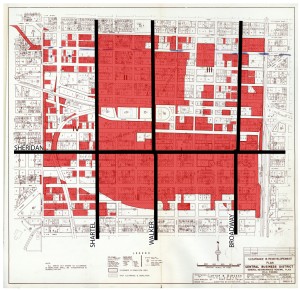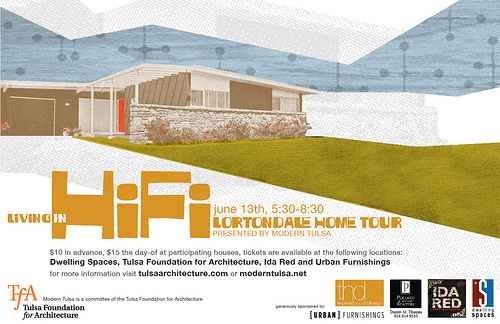Oklahoma History: June 2009 Archives
There are a couple of tours happening in and around Tulsa this weekend that may tickle your fancy:
An all-day bus tour of historic all-black towns will take place this Saturday, from 7 am to 5 pm. Freed slaves from the Muscogee (Creek) Nation founded a number of towns south and east of Tulsa around the turn of the 20th century. Other towns were established in the newly opened Oklahoma Territory at the end of the 19th century as part of a black statehood movement.
The tour is $30. For information and to make reservations call 918-596-7280. (Found via TheMidtowner.)
This New York Times story is a good introduction to Oklahoma's all-black towns. Alison Zarrow has made her photoessay on Oklahoma's black towns, Wish You Were Here, available online.
This Saturday evening, 5:30 to 8:30 pm, the Modern Tulsa committee of the Tulsa Foundation for Architecture is hosting a tour of homes in the mid-century modern neighborhood of Lortondale, east of Yale Ave. between 26th and 28th Streets.
Designed and built in 1954 by Tulsa duo Donald Honn (architect) and Howard Grubb (builder), the Lortondale Neighborhood was the recipient of a multitude of national design awards. The neighborhood was featured in an array of magazines including House and Home and Better Homes and Gardens.In recent years Lortondale has experienced something of a rebirth. A new generation of homeowners, interested in modern design, are snapping up the houses just as fast as they come on the market. After decades of neglect, many of the houses in the neighborhood are being restored to their former modern glory. Most importantly, the Lortondale Community is experiencing the same restoration.
This year's tour seeks to convey the energy that is the Lortondale Neighborhood today. Featured are 6 houses in various stages of completion. From the beginning stages of a restoration to a virtually complete example of HiFi-modern bliss, this tour of Lortondale will show you what all the buzz is about.
Tickets are $10 in advance, $15 the day of the tour, and available at Dwelling Spaces, Urban Furnishings, Ida Red Boutique, and the Tulsa Foundation for Architecture office. All the details are available at the Modern Tulsa website.
The tour is self-paced. You can start at any home and purchase a ticket at the first house you visit:
- 4912 E. 26th Terrace
- 5331 E. 26th Pl.
- 5342 E. 26th Pl.
- 4953 E. 27th St.
- 4958 E. 27th St.
- 5312 E. 27th St.
There's an ongoing online tour you can follow vicariously. A family is visiting all 77 of Oklahoma's counties, taking photos, and recounting their travels. You can follow their progress on the 77 Counties blog. (The latest entries will also be linked on the BatesLine Oklahoma headlines page.)
More linkage, less thinkage, until I get out from under the pile:
Abandoned Oklahoma is a website devoted to photography of abandoned places around the state. Homes, industrial sites, parks, schools, churches. Sites include the Labadie Mansion in Copan (north of Bartlesville), the Santa Fe Depot in Cushing, the Page-Woodson School in Oklahoma City, the Hissom Memorial Center near Sand Springs. The photos are fascinating, often poignant.
A similar site, Underground Ozarks, has several pages devoted to Monte Ne, southeast of Rogers, Ark.
The abandoned million-dollar resort known as Monte Ne was the dream of former Liberty Party presidential candidate William Hope "Coin" Harvey. In 1901, the eccentric Harvey purchased 320 acres near Rogers, Arkansas to become a health resort, political headquarters, and place for civilization to arise after the apocalypse (which Harvey believed was imminent). The resort had two massive hotels, an enclosed plunge bath, a golf course, and gondolas to ferry visitors across the lagoon. In later years, Harvey even added a Roman amphitheater, which is now submerged under Beaver Lake.
Russell Johnson has much more information about Monte Ne and Coin Harvey.
And now for a deliberate, man-made ruin:
(This really deserves an entry of its own, but for now I just want you to see the link.)
 Blair Humphreys is getting caught up on his blogging, and the most dramatic thing he's posted is this map of the Oklahoma City urban renewal plan. The map, created in 1965 by MIT-trained architect I. M. Pei and Carter & Burgess, defined the areas of downtown to be cleared and redeveloped according to the Pei plan. Blair has shaded the map to highlight the doomed zones. It's nearly everything from NW 6th to SW 3rd, from Western Ave. to the Santa Fe tracks. (Bricktown, east of the tracks, was spared.) Click through to see a much larger image and to read Blair's comments.
Blair Humphreys is getting caught up on his blogging, and the most dramatic thing he's posted is this map of the Oklahoma City urban renewal plan. The map, created in 1965 by MIT-trained architect I. M. Pei and Carter & Burgess, defined the areas of downtown to be cleared and redeveloped according to the Pei plan. Blair has shaded the map to highlight the doomed zones. It's nearly everything from NW 6th to SW 3rd, from Western Ave. to the Santa Fe tracks. (Bricktown, east of the tracks, was spared.) Click through to see a much larger image and to read Blair's comments.
Blair notes that "old plans can tell us a lot about how the city came to be the way it is." He has scans of many important Oklahoma City plans and hopes to put them all online in the future.
KOTV's Dan Bewley went to Yale, OK, today to report on the demolition of Yale's Norma S. Velvin auditorium, the only remaining piece of the 1930s high school building. According to the report, Superintendent Mike Wilson claims that there are no student records or transcripts in the building and that anything remaining is infected with mold or beyond repair. Alumni who object to the demolition say there are still computers, printers, and trophies in the building.
At this point, it would be very difficult for someone to check on the contents of the building, although I'm told that demolition has been halted or at least slowed over concerns about a failure to remove asbestos. If in fact there is nothing of value left in the building, the superintendent would be more persuasive if he released a complete list of what was left in place and what was removed. Likewise, it would be easier to believe that no transcripts or student records were left if he would account for where all student records are currently stored.
Click the link to see the KOTV video:
